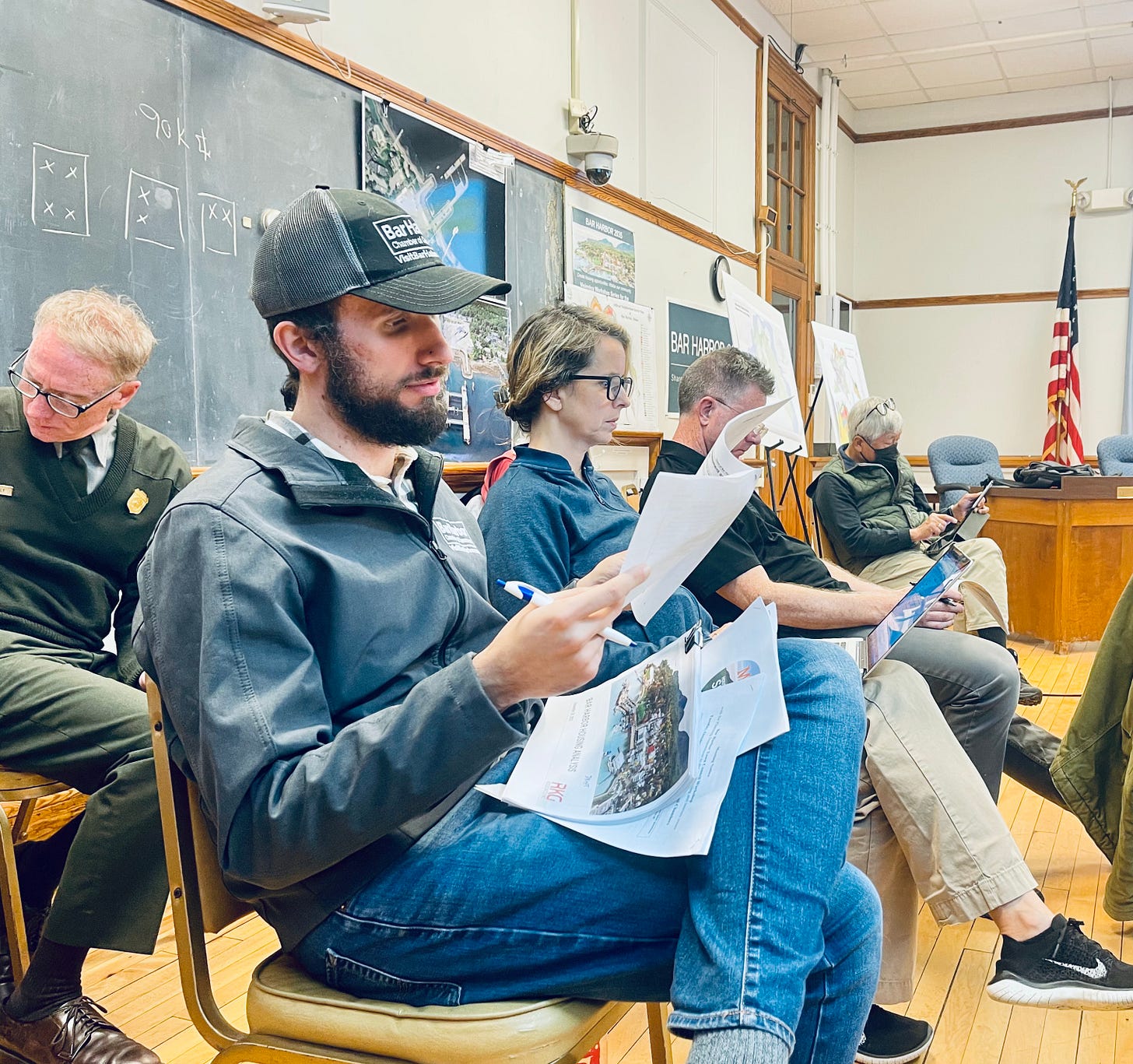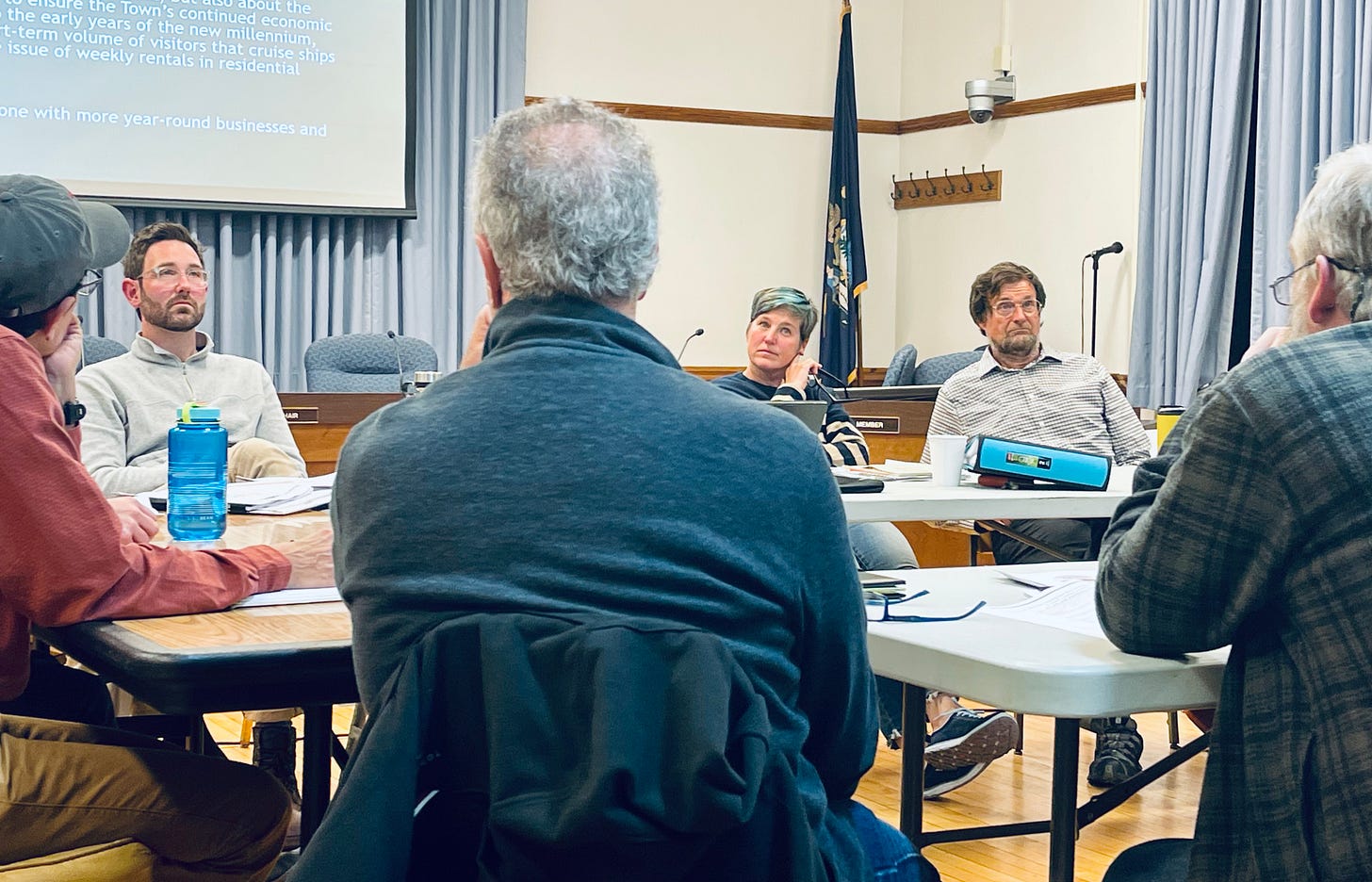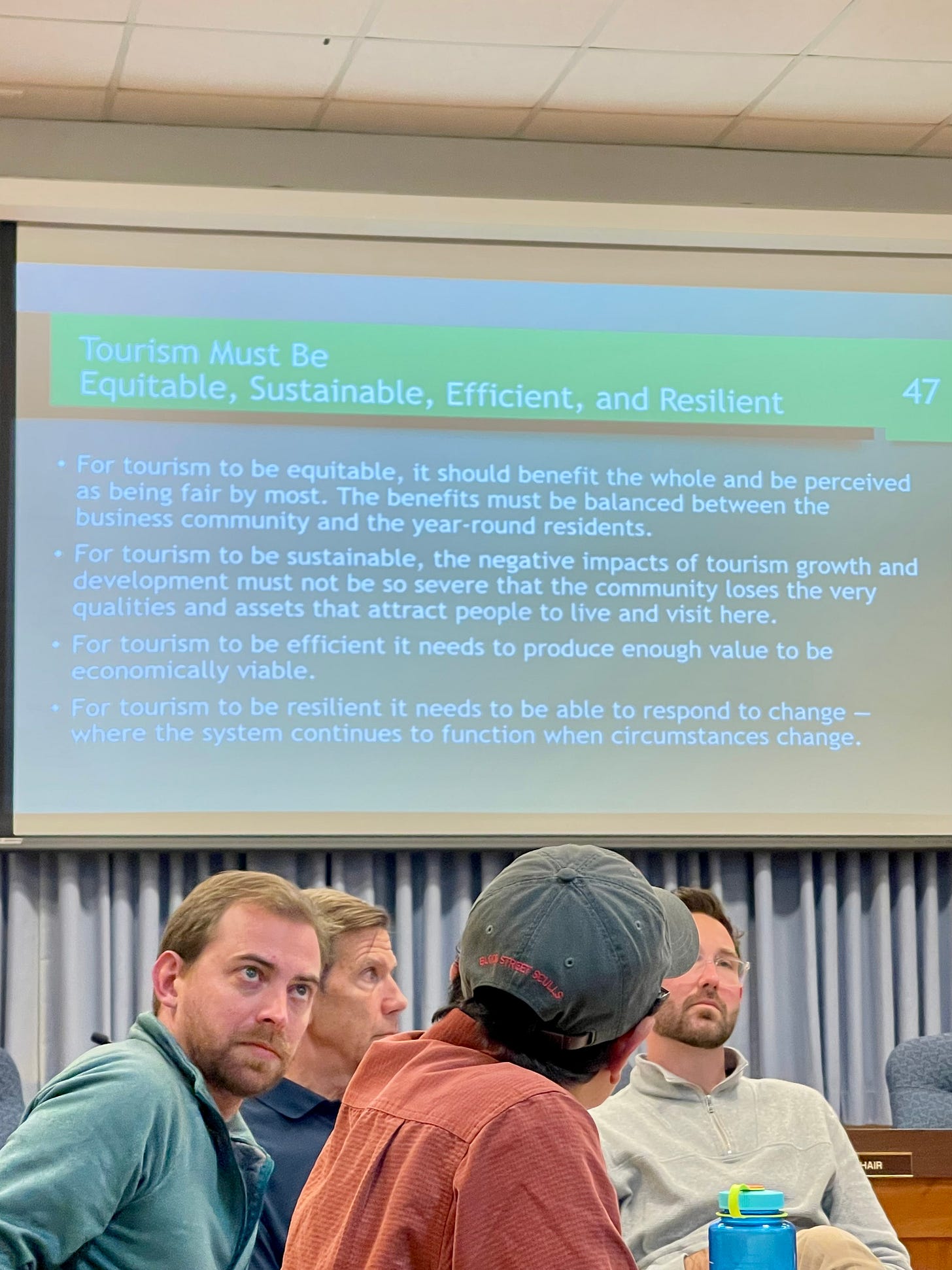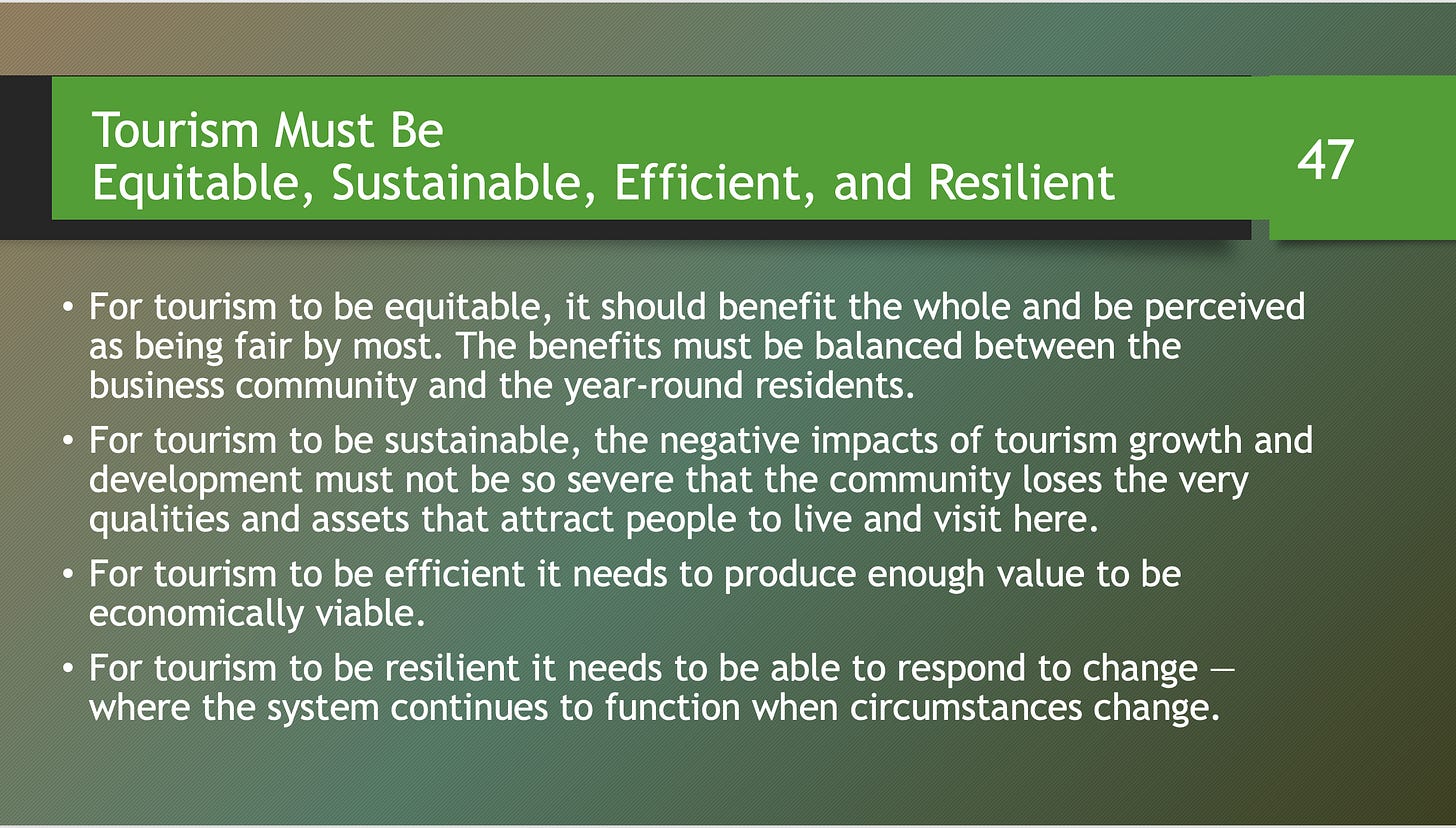As Season Comes to an End, Tourism Talks Begin
Town Council and Planning Board Hold Joint Workshop
BAR HARBOR—Tourism and community have been entwined concerns in Bar Harbor for a long time, which Town Planning Director Michele Gagnon demonstrated by reading the 1962 Comprehensive Plan excerpt about these two things during the Tuesday night Town Council and Planning Board workshop about tourism and housing.
Then she plucked an excerpt from the 1980 Comprehensive Plan.
There were a couple chuckles.
She followed that with a snippet from the Mount Desert Island League of Women Voters’ 1988 Cumulative Impact of Development
The 2007 Comp Plan? Much of the same thing.
“Tourism has been something that’s been grown, that’s been growing,” Gagnon said, and the town has been talking about it since before 1960.
“In 2023 we are having the same conversation,” she said.
This latest round, she said, feels like residents might be ready to enact some change because of vacation rental limits and cruise ship limits that were passed.
She posed eight questions to the Town Council and Planning Board, which had gathered for the joint workshop.
Is tourism impacting what made Bar Harbor, Bar Harbor?
Are we losing what we value?
Are the costs of tourism outweighing the benefits?
Has Bar Harbor changed in unsettling ways?
Has our tolerance to visitors decreased?
Does the tourists’ expectations match the tourists’ experience?
Are we losing the ability to absorb more tourism?
Have we crossed the tipping point?
She then went over the memo sent to the council and board. Before launching into a strategy, she suggested that they should understand data and statistics as well as surveys from residents about attitudes and feelings. She suggested listening sessions to talk about the whole tourism picture in Bar Harbor and then potentially using that information to decide how the town might move forward. She, Housing and Community Planner Cali Martinez, and Deputy Code Enforcement Officer Mike Gurtler cautioned that for every issue, or even every situation or experience, there are multiple truths and viewpoints.
How do you address all those truths for one commonality, Martinez asked.
A discussion about data and attitude followed.
Council Vice Chair Gary Friedmann said that too much data isn’t useful to policy makers and that it can be overwhelming. He later verified that he was referring to the “Bar Harbor Housing Analysis” draft released December 28, 2022. The document is over 80 pages.
Shank said he respectively disagreed and said that the objective data about things as simple as sales tax can tell a story, while a survey of people’s opinions about feelings is not as objective and can even be influenced by how a sentence on that survey is phrased.
“Everything we gather (via survey) is purely subjective, but there’s a lot of objective information” available, or that could be available, that many are ignorant of, Shank said. That information is needed to make a decision. He requested the town take a nuanced approach to survey questions and ask for help from social scientists and survey professionals.
He also worried about Gagnon’s use of the phrase “baseline” in one of the points in her memo. “We aren’t gathering a baseline on anything. We’re gathering a baseline of now.”
Councilor Matthew Hochman said that he hears a lot of people lamenting what Bar Harbor has lost. Some of the changes are tourism related, he said, but some are societal related. Car dealerships, clothing stores are absent from many small communities, he said.
“That model of a small town America doesn’t really exist anymore,” he said. “We need to identify some of the things that make us a community now moving forward,” rather than 20 years ago. That’s hard, he said, because people have a sense of nostalgia over what Bar Harbor was.

Councilor Maya Caines said that she has a hard time grappling with what Bar Harbor used to be in past decades because she wasn’t here at the time. However, she thinks that the amenities like clothing stores are currently needed when there are many seasonal residents and people who don’t drive.
Councilor Joe Minutolo said there is an economic component (sales tax revenue for the state) and the emotional component (congestion and lack of services) to tourism.
“People feel disenfranchised,” he said. The key is to try to find the balance of a strong economic foundation and the ability to enjoy the place. Growth, he said, has to be prepared for and supported. “We’re tied to our infrastructure and our infrastructure has not improved.”
John Kelly, the chair of the Parks and Recreation Committee and Comprehensive Planning Committee member said that the town needs to think about the outside influencers that get people to come here. Those, he said, are social media, state tourism industry, cruise ship industry, and bussing industry.
The park visitation number has grown by 70% in ten years, he said.
According to the data, between 2012 and 2022, visitation has increased by 63%. The park’s official 2023 numbers are not out yet because the season has not ended. Kelly’s point is that
Acadia’s growth in visitation hasn’t come from the National Park Services recently because the park doesn’t promote its use.
Shifting the tone a bit, Gurtler said everyone in the room is successful. “We all live here,” he said.
He said that there are a lot of positive things that come out of tourism and negative things. Like Shank, he said that anecdotal information shouldn’t be used to make decisions. Also like Shank, he said that “we should always listen. We should also remember that with every conversation there are three sides.”
“You really need to focus on some of the positive stuff, too,” Gurtler said
SALES TAXES AND BAR HARBOR
Former Town Councilor Stephen Coston asked how much is remitted to sales tax and if the town could ask the state to reconsider that formula since Bar Harbor has to uphold an infrastructure via property tax that supports a local tourism economy that sends more than $200 million via sales and lodging taxes to the state. The state then disperses that money to other municipalities.
That is part of the reason tourism is being framed as a problem, not an opportunity, he said. “We are subsidizing the entire state.”
Think of how many millions of dollars of projects could be supported if the town received just 10 percent of that back, which would be $1-2 million, he said.
As we reported last December, in 2021, Bar Harbor generated $236 million in restaurant and lodging sales tax revenue for Maine, but less than 1% of that comes back to the town.
“In this current fiscal year, we budgeted $616,600 for state aid for our schools and $350,000 of revenue sharing for municipal services. That’s $966,600,” former Town Manager Kevin Sutherland had said at the time. “Less than one percent. Less than half of one percent is coming back to the community in which it was generated.”
The revenues that are generated by the town are passed onto the state, but not the town itself for its infrastructure needs to support the tourism that creates the revenue.
“We’re getting $20 million of that benefit sucked right out of our community and not getting it back,” Coston said. “It’s a big, giant pink elephant in the room.”
Minutolo said it’s true and that the town can demonstrate that it has hardship.
“We’re getting such a raw deal from the state. We’re getting hammered,” Coston said. He suggested contacting the town’s state representative, Lynne Williams, about advocacy.
The tourism conversation will likely be continued at other meetings and workshops, Town Council Chair Valerie Peacock said.
All green images like the one above are from Gagnon’s presentation.
LINKS TO LEARN MORE
https://barharborstory.substack.com/p/town-manager-delves-into-potential














